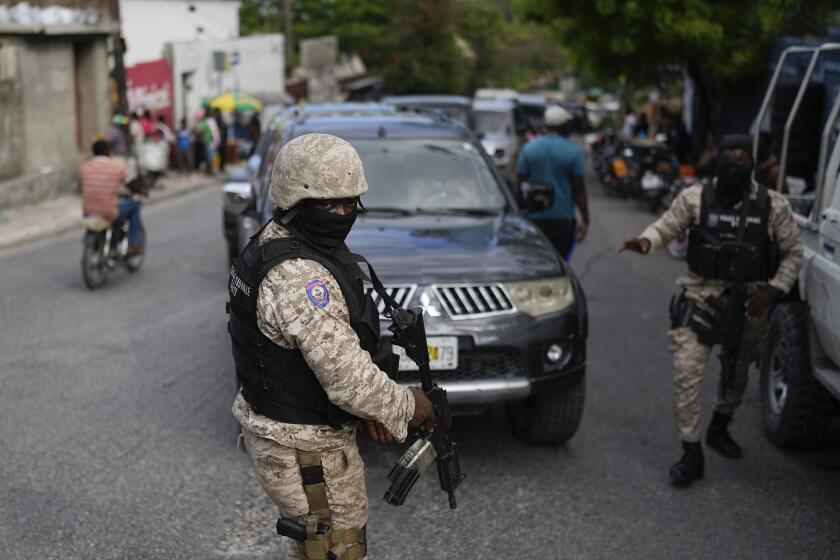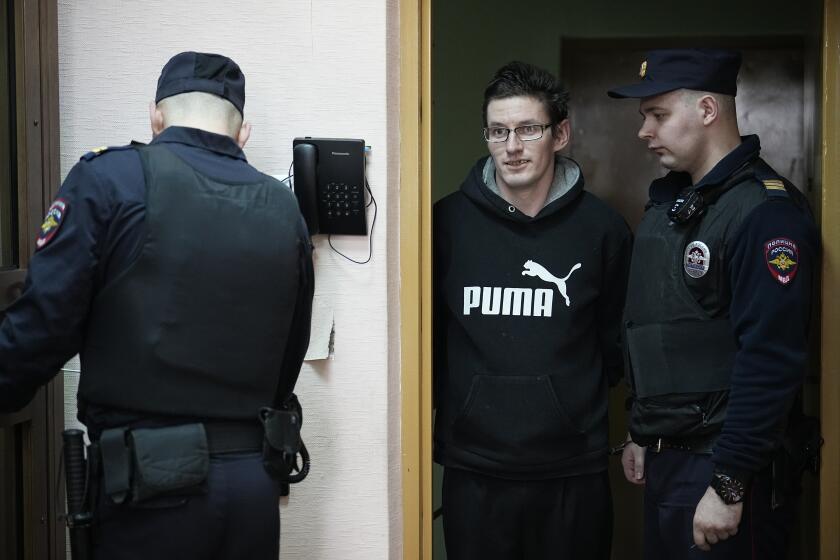Field trip to world religions never leaves L.A.
In his quest to have students experience firsthand how people around the world worship, Varun Soni, the dean of religious life at USC, did not start up some expensive study-abroad program. He just ventured a few blocks from campus.
Within a square mile, he and his staff discovered 67 places of worship. And that was without crossing the Harbor Freeway just to the east.
Earlier this semester, Soni started a weekly “Souljourn” to explore that religious diversity, bringing students of different faiths to churches of different faiths, from Hare Krishna to Tao to Pentecostal.
On Sunday about 10 a.m., four Wiccans, a Buddhist, a Sufi and an agnostic filed up the rickety stairs to the balcony of the Virgin Mary Ethiopian Orthodox Church. Hundreds of congregants filled the pews, many men wearing suit coats, women wrapped in gauzy white scarves. They chanted joyously with the choir in Amharic, tended restless children and clapped the deep detonations of the kubaro drum.
With no English translation, the students took in the distinct mix of African sound -- the ululating and drums -- with the Western fixtures of votive candles, incense and stained glass.
“It was beautiful,” said Jaclyn Kalkhurst, 23, who runs a Pagan-Wiccan group on campus. “We love the drums. We want to get one now.”
The service reminded her friend, MacKenzie Edwards, 18, of the African Methodist Episcopal church she attended growing up in Seattle. “The sermon, the intonation, the repetition was similar to services I experienced,” she said.
Soni, a Hindu, says he wants students not just to study religion, but to see how it “is lived.”
The volunteers who come along -- just for the experience, not for class credits -- sit in on the services and then meet with the congregants or clergy to ask questions about their faiths.
This semester, a revolving cast of students went to services at First African Methodist Episcopal Church, Chabad, Omar al Khattab Mosque, Senshin Buddhist Temple and Ministerios Manantial de Amor -- all near USC. And for a bit more variety they expanded their range, going to a Sikh Gurdwara in Los Feliz, a Krishna temple in Culver City, the Thien Hau Taoist Temple in Chinatown and the Church of the Nazarene on skid row.
The students Sunday said the visits have been fascinating and deepened their own faiths.
“In order to understand what you believe, it’s important to understand what other people believe,” Kalkhurst said.
The old stucco church on Compton Avenue is itself a testament to Los Angeles’ shifting diversity. Built as a synagogue in the 1930s, it was later taken over by an African American evangelical church, then bought by the Ethiopians as many blacks left the area and Latinos moved in.
“Some of our local Hispanic people say, ‘Why is your church here?’ ” said one of the church’s priests, Abba (Rev.) Thomas Finley. “I say, ‘We got a good deal on real estate.’ ”
Finley took questions from the students as they ate an Ethiopian meal of wat and spongy injera bread.
The priest was not your typical Ethiopian Orthodox officiant -- being a white Midwesterner with a big gray beard -- but he had a unique vantage from which to introduce newcomers to the religion. Finley, 62, grew up Catholic but did not like the reforms brought about by the Second Vatican Council in the 1960s, and sought something different. He became a member of the Russian Orthodox Church for 30 years before the spirit of the Ethiopian church captivated him.
“First it was a curiosity about the music and the chant,” he said. “I got more and more involved and discovered more and more. There is a certain joy in the worship. It’s infectious.”
He explained to Nazanin Angoshtari, 33, an Islamic Sufi, how the Ethiopian and Egyptian Christians, among others, split with the Romans over how to define the nature of Christ in 451 A.D. Romans defined Christ as both man and God, while Ethiopians were among the group that felt Christ had a single divine nature.
Finley laughed about how these technical rifts widened through history with racism and all manner of offenses and power plays.
“That’s the same story with the different seats of Islam,” said Angoshtari, who described the split between Sunni and Shiite Islam.
“Yeah, human nature can fall into the same traps no matter what the religions are,” Finley said.
Finley said there is an absolute truth, despite these disputes, which is all that matters and is in the heart of the believer.
Angoshtari agreed wholeheartedly. The mystical Sufist movement, she said, “is a journey to seek the truth.”
“When I listen to different people and listen to the things that change from one background to another, it helps me look for that absolute truth.”
--
More to Read
Start your day right
Sign up for Essential California for news, features and recommendations from the L.A. Times and beyond in your inbox six days a week.
You may occasionally receive promotional content from the Los Angeles Times.







